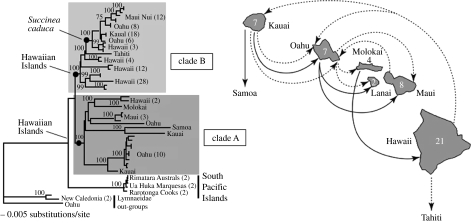Figure 3.
Inter-island colonization patterns for endemic Hawaiian succineid amber snails inferred from molecular phylogenetic data (Holland & Cowie in press). Arrows are based on nodes and clades in the tree, solid lines representing clade A and dotted lines representing clade B (Holland & Cowie in press). Numbers on islands are numbers of endemic succineid species on each island (Cowie et al. 1995). The two arrows, one from each of the two lineages, pointing southwards, one from the Island of Hawaii labelled ‘Tahiti’, the other from Kauai labelled ‘Samoa’, each represent a species from the South Pacific, suggesting historical colonization of these localities from the Hawaiian Islands. The phylogenetic tree was generated using corrected maximum likelihood in PAUP (Swofford 2002), based on three gene fragments, two mitochondrial and one nuclear (COI, 16S and 18S; 1740 bp). Succineid out-groups were selected based on their basal position in a global succineid phylogeny (Holland & Cowie in press). The shaded boxes highlight the two well-supported Hawaiian lineages, each of which maintains its integrity in the global phylogeny, with multiple lineages forming clades between them. The multi-island Hawaiian endemic species Succinea caduca is the only representative of clade B that occurs on islands other than the island of Hawaii (Holland & Cowie 2007).

